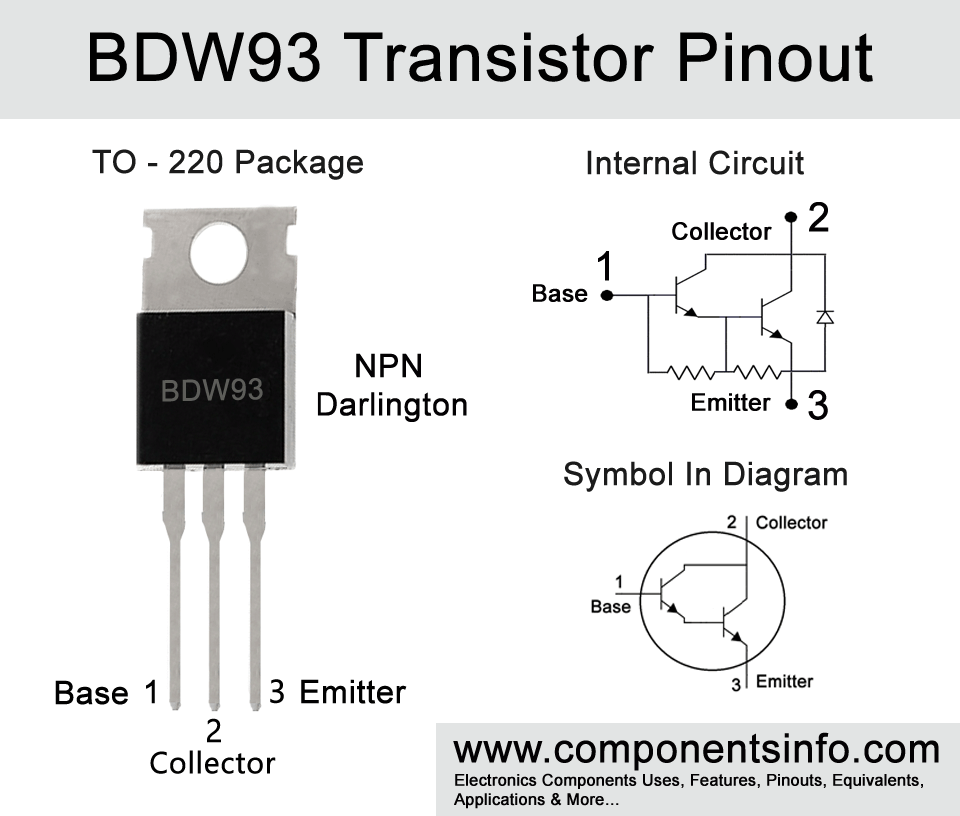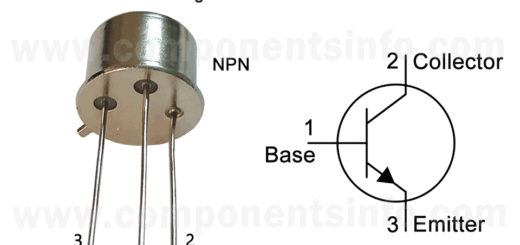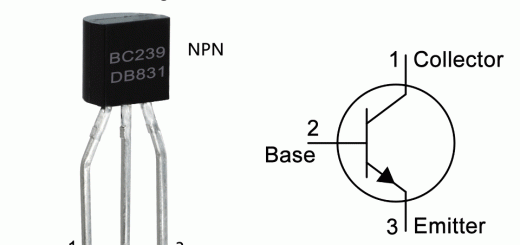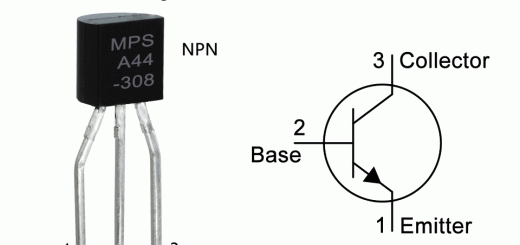BDW93 Transistor Pinout, Equivalents, Applications, Features and More
BDW93 is a TO-220 package NPN Darlington transistor. This post contains all the important information about this device such as BDW93 transistor pinout, equivalents, applications, features and more.
Absolute Maximum Ratings:
- Package Type: TO-220
- Transistor Type: NPN Darlington
- Max Collector Current(IC): 12A
- Max Collector-Emitter Voltage (VCEO): 45V
- Max Collector-Base Voltage (VCBO): 45V
- Max Emitter-Base Voltage (VEBO): 5V
- Max Continuous Base Current: 0.25A
- Max Collector Power Dissipation (Pc): 70 Watt
- Minimum DC Current Gain (hFE): 750 – 20,000
- Max Storage & Operating temperature: -65 to +150 Centigrade
PNP Complementary:
PNP Complementary of BDW93 is BDW94
Replacement and Equivalent:
BDW93, BDW9A, BDW93B, BDW93C, BDT87, BDT85
BDW93 Transistor Explained / Description:
BDW93 is an NPN transistor designed to be used in audio amplifiers and hammer drivers but can also be used in other applications. It is an NPN transistor, which means it contains two transistors inside, these two transistors are connected in a way that increases the output gain of the transistor to a very high value. Therefore if any signal is provided to its base the transistor will increase its gain to a very high value. But it is also important to know that with gain the noise with the signal will also be amplified so if you want to amplify the gain of a signal then you have to provide a low noise clean signal to the transistor or on its base.
Looking at the maximum ratings of the transistor the max collector current of the transistor is 12A, max collector-emitter voltage of the transistor is 45V, max collector-base voltage is also 45V, max emitter-base voltage is 5V, max continuous base current is 0.2A and max collector power dissipation is 80 Watt.
BDW93 is the transistor of BDW9X series which also contains other transistors such as BDW93A, BDW93B, and BDW93C.
Where We Can Use it & How to Use:
As mentioned above BDW93 is designed to be used in audio amplifier and hammer driver applications but it is not limited to use only in these applications and can also be used in other applications which you will find below.
To use the transistor first check its pin configuration then if you want to use it as a switch connect its Emitter pin with the negative supply of the circuit, connect its Base pin with the signal source and connect its collector with the negative side of the load and the positive side of the load will be connected with the positive rail of the circuit.
For using as an amplifier it is important to note that there are many types of amplifiers you can build with the transistors but in this example, we are guiding to build a simple one transistor amplifier circuit. To do so connect the Emitter pin with the negative supply, connect Base pin with the signal source through a ceramic capacitor for example 102 or 103 or you can also use an electrolytic capacitor. And connect the collector of the transistor with the negative supply of the load and the positive supply of the load will be connected.
Applications:
Voltage regulators
Voltage inverters
LED Drivers
Switching Circuits
Driver circuits
Switching regulator
Motor Control
DC to DC Converter
Inverter Circuits
Audio power amplifier
Voltage Regulation
Pulse Generator
Relay Drivers
Motor Control
Audio Amplifiers
Battery Operated Applications
Safe Operating Guidelines:
Here are the operating guidelines of the transistor.
- One of the most important rule for any electronic component is to not drive the component to its absolute maximum ratings and always stay 20% below its maximum ratings.
- The maximum collection current of the transistor is 12A which means it can drive load of upto 12A but according to the above rule, we will not drive a load of more than 9.6A.
- The maximum collector to emitter voltage or load voltage is 45V, so we will not drive load of more than 36V.
- The transistor should be operated under its temperature limits of -55°C to 150°C.
Datasheet:
To download the datasheet just copy and paste the below link in your browser.
https://datasheetspdf.com/pdf-down/B/D/W/BDW93_FairchildSemiconductor.pdf



